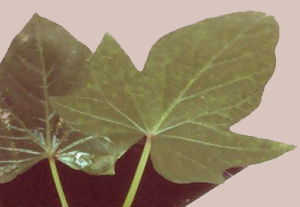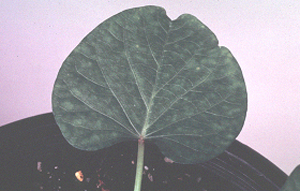|
|
Kingdom |
Virus |
|
Family |
Caulimoviridae |
|
Genus |
Caulimovirus
(probable) |
Reported
in several countries. Impacts on yield are unknown.
The
virus was first detected in sweetpotato originating from Puerto Rico. It has
been found in a complex with sweetpotato feathery mottle virus (SPFMV)
from the South Pacific Region (including Tonga, Papua New Guinea, New Zealand,
Solomon Islands, Australia and New Zealand), Madeira, Kenya, Uganda, and U.S.A.
Sweetpotato plants
infected with SPCaLV usually show no obvious viral symptoms. Sometimes infected plants
may show interveinal chlorosis
or faint chlorotic spots which
may develop into general chlorosis, wilting and premature death of leaves.
This virus has isometric particles 50 nm in diameter that contain a major
polypeptide of Mr 42-44 KD and dsDNA. SPCaLV is not serologically related
to other caulimoviruses: cauliflower mosaic, dahlia mosaic, carnation etched
ring and soybean chlorotic mottle.
Virus particles and characteristic intracellular inclusions
induced by the virus are readily detected in the cytoplasm of epidermal and vascular
parenchyma cells of infected plants.
Ultra structural studies have shown that infected vascular parenchyma cells
containing inclusions sometimes protrude into, and so cause occlusion
of adjacent xylem vessels, which results in
wilting and premature abscission of infected leaves.
SPCaLV is not mechanically transmitted or by seed or by contact
between plants. Its vector is unknown. The virus does not appear to be
transmitted by aphids M. persicae and Aphis gossypii.
The only known natural host of SPCaLV is Ipomoea batatas.
In the laboratory, SPCaLV can be made to infect Ipomoea setosa and Nicotiana
megalosiphon.
Regulatory control
International exchange of virus-free germplasm.
Cultural control
Use of healthy planting materials.
Atkey, P.T. and Brunt, A.A. 1987. Electron microscopy of
an isometric caulimo-like virus from sweet potato (Ipomoea batatas). J.
Phytopathol. 118: 370-376.
Brunt A.A., Crabtree K., Dallwitz, M.J., Gibbs, A.J., and
Watson, L. (eds.). 1996. Viruses of Plants: Descriptions and lists from the VIDE
database. CAB INTERNATIONAL, Cambridge, UK. 1484 p.
Brunt, A.A., Crabtree, K., Dallwitz, M.J., Gibbs, A.J., Watson, L. and
Zurcher, E.J. (eds.) (1996 onwards). `Plant Viruses Online: Descriptions and
Lists from the VIDE Database. Version: 20th August 1996.' URL
http://biology.anu.edu.au/Groups/MES/vide/
Clark, C.A., and Moyer, J.M. 1988. Compendium of sweetpotato diseases. The
American Phytopahological Society. APS Press, Minnesota, USA. 74 p.
Contributed
by: Segundo Fuentes
and Luis Salazar |
Taxonomy
Economic
importance
Geographical
distribution
Symptoms
Morphology
Biology
and ecology
Host
range
Management
References

Pale
spots between leaf veins due to SPCaLV (S. Fuentes & L. Salazar).

Discolouration
between veins (chlorosis) that may
also be described as faint mottling
(S. Fuentes & L. Salazar).

Chlorotic
flecks along the secondary veins and interveinal chlorotic spots on leaf
of a SPCaLV graft-inoculated Ipomoea setosa plant. (Right) Leaf
from a healthy plant (S. Fuentes & L. Salazar).
|

